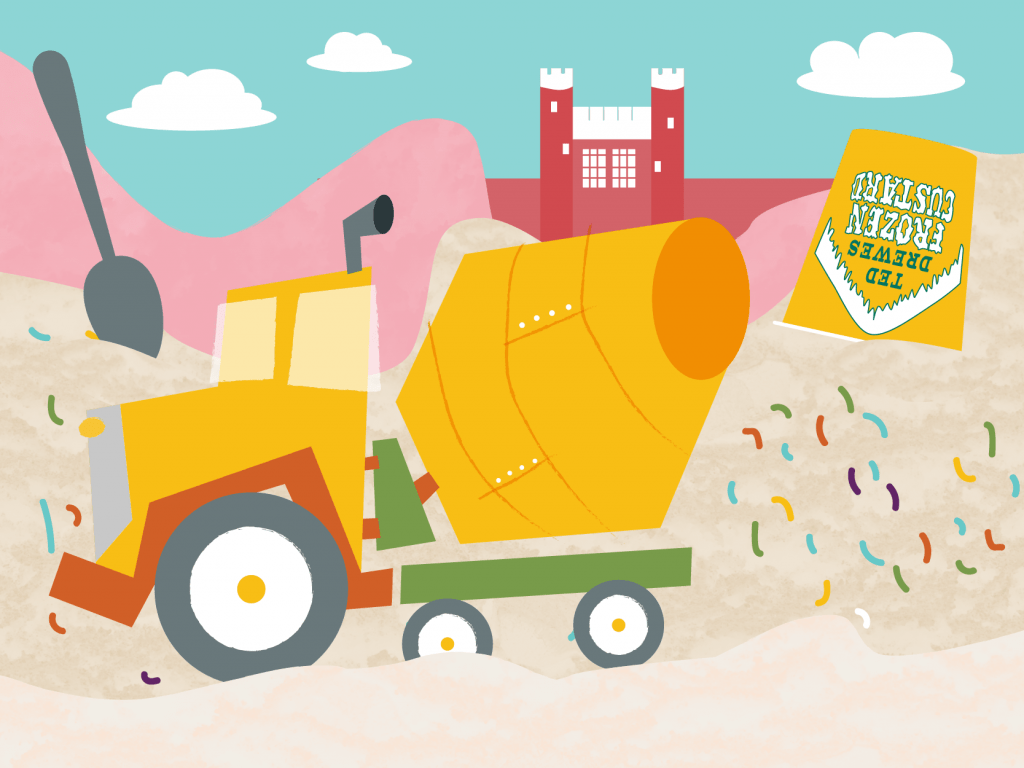By Diane Torian Keaggy
What did the concrete worker at Washington University in St. Louis say to his buddy?
“This job is getting harder and harder.”
Indeed, since last July, some 20,000 cubic yards of concrete have been poured at the East End Transformation of the Danforth Campus. And another 25,000 will be poured in the next 18 months. Two of the new structures — the parking garage and Jubel Hall — are “full concrete” structures, composed entirely of concrete. The other buildings, including Weil Hall, the Sumers Welcome Center and the Schnuck Pavilion, will have concrete foundations and steel floors.
McCarthy Building Companies, Inc., the project’s general contractor, has devoted 75 workers to the concrete task. They are responsible for building the projects’ concrete forms (think of them like slices of bread stuffed with rebar) into which concrete is poured.
The work demands precision and patience, said Ryan Moss, project director for the East End Transformation.
“We want to pour the concrete really slowly because it’s a lot of weight and pressure,” Moss said. “One worst-case scenario: You pour so fast that you blow out the form. The other: You pour so slow and the concrete sets. In that case, you’ve just created a cold joint that water will enter through — and it looks terrible.”
And no one wants that. After all, these structures are built to last. Unlike most materials, concrete strengthens with time.
“Ask anyone on our crew if they would rather tear down a 10-year-old building or a 50-year-old building, and they will tell you the 10-year-old one,” Moss said. “Concrete is like a good wine — it gets better over time.”
Want to cement your knowledge of concrete? Take our quiz:
1) Jubel Hall will be composed entirely of concrete to:
A. Minimize vibrations in research laboratories.
B. Provide a fortress against marauding biomedical engineers from Brauer Hall.
2) The aggregate in East End concrete is composed primarily of:
A. Specimens from WashU’s Baby Teeth study.
B. Gravel from the Meramec River.
3) How is the strength of the East End concrete tested?
A. An independent testing lab evaluates the composition of each pour to make sure it matches its specified strength.
B. The concrete repeatedly takes an organic chemistry final until it cracks.
4) Concrete was discovered in:
A. 6,500 B.C by Bedouins, who used concrete-like materials to construct rubble-wall houses, floors and cisterns.
B. 1959 by Ted Drewes Jr., who mixed a milkless-milkshake for some neighborhood kid who demanded a thicker shake.
5) Like a good salad, concrete is best:
A. Drenched in Hidden Valley Ranch.
B. Fresh and locally sourced.
6) The East End concrete budget is $45 million, enough to buy:
A. 1,051,647 Tonka cement mixers.
B. 150 sets of “traffic-calming” balls.
7) Concrete work was halted during the first week of January because:
A. Cement plants cannot mix concrete in sub-freezing temperatures.
B. Concrete workers still were recovering from the New Year’s Eve rager at Chancellor Wrighton’s house.
Answers:
- A. B is technically correct, but it’s just a bonus.
- B. Meramec gravel, mined from the Meramec River, also used in campus sidewalks and recognizable for its brown pebbles.
- A. An independent lab fills cylinders with concrete samples and conducts compressive strength tests at 7, 14 and 28 days.
- A. and B. are both correct.
- B. Unlike steel, concrete must be mixed fresh and near the building site. In the case of remote building and road construction, crews will erect a mobile plant.
- B. Though we know some folks in South St. Louis who would give you the ones in the neighborhood for free.
- A. Though additives can be mixed into concrete to keep it from freezing, the temperatures in early January were simply too cold for local plants to stay open. But we like to imagine B. is true.
